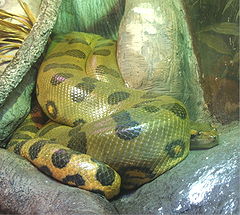
Anaconda
Background to the schools Wikipedia
SOS Children volunteers helped choose articles and made other curriculum material A good way to help other children is by sponsoring a child
An anaconda is a large, non-venomous snake found in tropical South America. Although the name actually applies to a group of snakes, it is often used to refer only to one species in particular, the common or green anaconda, Eunectes murinus, which is one of the largest snakes in the world.
Anaconda may refer to:
- Any member of the genus Eunectes, a group of large, aquatic snakes found in South America
- Eunectes murinus, the green anaconda, the largest species, is found east of the Andes in Colombia, Venezuela, the Guianas, Ecuador, Peru, Bolivia, Brazil and Trinidad and Tobago.
- Eunectes notaeus, the yellow anaconda, a small species, is found in eastern Bolivia, southern Brazil, Paraguay and northeastern Argentina.
- Eunectes deschauenseei, the darkly-spotted anaconda, is a rare species found in northeastern Brazil and coastal French Guiana.
- Eunectes beniensis, the Bolivian anaconda, the most recently defined species, is found in the Departments of Beni and Pando in Bolivia.
- The giant anaconda is a mythical snake of enormous proportions said to be found in South America.
- Any large snake that "crushes" its prey (see Constriction), if applied loosely, could be called anaconda.
Etymology
Various theories exist regarding the origin of the name itself. The most widely accepted one suggests it was derived from the Sinhala henakandaya since the phonetic sounds are very similar. However, this name is used to refer to the brown vine snake, Ahaetulla pulverulenta, a slender, arboreal species that grows to five feet (152 cm) at most and feeds only on small vertebrates. Another theory by Yule and Burnell (1886) is based on an entry in the Catalogue of Indian Serpents from the Leyden Museum (Ray, 1693) that reads: Anacondaia Zeylonensibus, id est Bubalorum aliorumque jumentorum membra conterens, meaning "the anacondaia of the Ceylonese, i.e. he that crushes the limbs of buffaloes and yoke beasts." Without a clear Sinhala connection, they suggest one from the Tamil language instead: anai-kondra (anaik-konda), meaning "which killed an elephant.” Per National Geographic, the word anaconda comes from the Tamil word anaikolra, which means elephant killer.
The name was first used in the English language in 1768 by V. Jonasson in a colorful description of a large snake found in Ceylon (now Sri Lanka), most likely a reticulated python, Python reticulatus. The account, which explains how the snake crushes and devours tigers, is full of popular misconceptions, but was much read at the time, and so gave rise to the myth of the anaconda of Ceylon.


